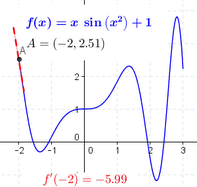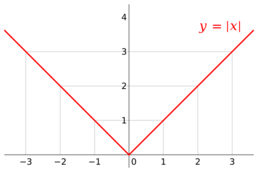Derivative
 From HandWiki - Reading time: 26 min
From HandWiki - Reading time: 26 min
| Part of a series of articles about |
| Calculus |
|---|
The derivative is a fundamental tool of calculus that quantifies the sensitivity of change of a function's output with respect to its input. The derivative of a function of a single variable at a chosen input value, when it exists, is the slope of the tangent line to the graph of the function at that point. The tangent line is the best linear approximation of the function near that input value. For this reason, the derivative is often described as the instantaneous rate of change, the ratio of the instantaneous change in the dependent variable to that of the independent variable.[1] The process of finding a derivative is called differentiation.
There are multiple different notations for differentiation, two of the most commonly used being Leibniz notation and prime notation. Leibniz notation, named after Gottfried Wilhelm Leibniz, is represented as the ratio of two differentials, whereas prime notation is written by adding a prime mark. Higher order notations represent repeated differentiation, and they are usually denoted in Leibniz notation by adding superscripts to the differentials, and in prime notation by adding additional prime marks. The higher order derivatives can be applied in physics; for example, while the first derivative of the position of a moving object with respect to time is the object's velocity, how the position changes as time advances, the second derivative is the object's acceleration, how the velocity changes as time advances.
Derivatives can be generalized to functions of several real variables. In this generalization, the derivative is reinterpreted as a linear transformation whose graph is (after an appropriate translation) the best linear approximation to the graph of the original function. The Jacobian matrix is the matrix that represents this linear transformation with respect to the basis given by the choice of independent and dependent variables. It can be calculated in terms of the partial derivatives with respect to the independent variables. For a real-valued function of several variables, the Jacobian matrix reduces to the gradient vector.
Definition
As a limit
A function of a real variable
If the function
For example, let
The ratio in the definition of the derivative is the slope of the line through two points on the graph of the function
Using infinitesimals
One way to think of the derivative
Continuity and differentiability
If
Most functions that occur in practice have derivatives at all points or almost every point. Early in the history of calculus, many mathematicians assumed that a continuous function was differentiable at most points.({{{1}}}, {{{2}}}) Under mild conditions (for example, if the function is a monotone or a Lipschitz function), this is true. However, in 1872, Weierstrass found the first example of a function that is continuous everywhere but differentiable nowhere. This example is now known as the Weierstrass function.[8] In 1931, Stefan Banach proved that the set of functions that have a derivative at some point is a meager set in the space of all continuous functions. Informally, this means that hardly any random continuous functions have a derivative at even one point.[9]
Notation
One common symbol for the derivative of a function is Leibniz notation. They are written as the quotient of two differentials
Another common notation for differentiation is by using the prime mark in the symbol of a function
In Newton's notation or the dot notation, a dot is placed over a symbol to represent a time derivative. If
Another notation is D-notation, which represents the differential operator by the symbol
Rules of computation
In principle, the derivative of a function can be computed from the definition by considering the difference quotient and computing its limit. Once the derivatives of a few simple functions are known, the derivatives of other functions are more easily computed using rules for obtaining derivatives of more complicated functions from simpler ones. This process of finding a derivative is known as differentiation.[17]
Rules for basic functions
The following are the rules for the derivatives of the most common basic functions. Here,
- Derivatives of powers:
- Functions of exponential, natural logarithm, and logarithm with general base:
- Trigonometric functions:
- Inverse trigonometric functions:
Rules for combined functions
Given that the
- Constant rule: if
- Sum rule:
- Product rule:
- Quotient rule:
- Chain rule for composite functions: If
Computation example
The derivative of the function given by
Higher-order derivatives
Higher order derivatives means that a function is differentiated repeatedly. Given that
In one of its applications, the higher-order derivatives may have specific interpretations in physics. Suppose that a function represents the position of an object at the time. The first derivative of that function is the velocity of an object with respect to time, the second derivative of the function is the acceleration of an object with respect to time,[17] and the third derivative is the jerk.[23]
In other dimensions
Vector-valued functions
A vector-valued function
Partial derivatives
Functions can depend upon more than one variable. A partial derivative of a function of several variables is its derivative with respect to one of those variables, with the others held constant. Partial derivatives are used in vector calculus and differential geometry. As with ordinary derivatives, multiple notations exist: the partial derivative of a function
among other possibilities.({{{1}}}, {{{2}}}) It can be thought of as the rate of change of the function in the
This is fundamental for the study of the functions of several real variables. Let
Directional derivatives
If
If all the partial derivatives of
Total derivative, total differential and Jacobian matrix
When
If the total derivative exists at
Generalizations
The concept of a derivative can be extended to many other settings. The common thread is that the derivative of a function at a point serves as a linear approximation of the function at that point.
- An important generalization of the derivative concerns complex functions of complex variables, such as functions from (a domain in) the complex numbers
- Another generalization concerns functions between differentiable or smooth manifolds. Intuitively speaking such a manifold
- Differentiation can also be defined for maps between vector space, such as Banach space, in which those generalizations are the Gateaux derivative and the Fréchet derivative.[36]
- One deficiency of the classical derivative is that very many functions are not differentiable. Nevertheless, there is a way of extending the notion of the derivative so that all continuous functions and many other functions can be differentiated using a concept known as the weak derivative. The idea is to embed the continuous functions in a larger space called the space of distributions and only require that a function is differentiable "on average".[37]
- Properties of the derivative have inspired the introduction and study of many similar objects in algebra and topology; an example is differential algebra. Here, it consists of the derivation of some topics in abstract algebra, such as rings, ideals, field, and so on.[38]
- The discrete equivalent of differentiation is finite differences. The study of differential calculus is unified with the calculus of finite differences in time scale calculus.[39]
- The arithmetic derivative involves the function that is defined for the integers by the prime factorization. This is an analogy with the product rule.[40]
See also
Notes
- ↑ Stewart 2002, p. 129–130.
- ↑ Gonick 2012, p. 83.
- ↑ Gonick 2012, pp. 77–80.
- ↑ Thompson 1998, pp. 84–85.
- ↑ Keisler 2012, pp. 902–904.
- ↑ 6.0 6.1 Gonick 2012, p. 156.
- ↑ Gonick 2012, p. 149.
- ↑ David 2018.
- ↑ Banach 1931, cited in Hewitt & Stromberg 1965.
- ↑ Apostol 1967, p. 172.
- ↑ Cajori 2007, p. 204.
- ↑ Moore & Siegel 2013, p. 110.
- ↑ 13.0 13.1 13.2 Varberg, Purcell & Rigdon 2007, p. 125–126.
- ↑ In the formulation of calculus in terms of limits, various authors have assigned the
- ↑ Schwartzman 1994, p. 171.
- ↑ Cajori 1923.
- ↑ 17.0 17.1 Apostol 1967, p. 160.
- ↑ Varberg, Purcell & Rigdon 2007. See p. 133 for the power rule, p. 115–116 for the trigonometric functions, p. 326 for the natural logarithm, p. 338–339 for exponential with base
- ↑ For constant rule and sum rule, see Apostol 1967, p. 161, 164, respectively. For the product rule, quotient rule, and chain rule, see Varberg, Purcell & Rigdon 2007, p. 111–112, 119, respectively. For the special case of the product rule, that is, the product of a constant and a function, see Varberg, Purcell & Rigdon 2007, p. 108–109.
- ↑ Warner 1983, p. 5.
- ↑ Debnath & Shah 2015, p. 40.
- ↑ Carothers 2000, p. 176.
- ↑ Stewart 2002, p. 193.
- ↑ 24.0 24.1 Stewart 2002, p. 893.
- ↑ Stewart 2002, p. 949.
- ↑ Mathai & Haubold 2017, p. 52.
- ↑ Gbur 2011, pp. 36–37.
- ↑ Varberg, Purcell & Rigdon 2007, p. 642.
- ↑ Guzman 2003, p. 35.
- ↑ 30.0 30.1 30.2 Davvaz 2023, p. 266.
- ↑ Lee 2013, p. 72.
- ↑ Davvaz 2023, p. 267.
- ↑ Roussos 2014, p. 303.
- ↑ Gbur 2011, pp. 261–264.
- ↑ Gray, Abbena & Salamon 2006, p. 826.
- ↑ Azegami 2020. See p. 209 for the Gateaux derivative, and p. 211 for the Fréchet derivative.
- ↑ Funaro 1992, p. 84–85.
- ↑ Kolchin 1973, p. 58, 126.
- ↑ Georgiev 2018, p. 8.
- ↑ Barbeau 1961.
References
- Apostol, Tom M. (June 1967), Calculus, Vol. 1: One-Variable Calculus with an Introduction to Linear Algebra, 1 (2nd ed.), Wiley, ISBN 978-0-471-00005-1, https://archive.org/details/calculus01apos
- Azegami, Hideyuki (2020), Shape Optimization Problems, Springer Optimization and Its Applications, 164, Springer, doi:10.1007/978-981-15-7618-8, ISBN 978-981-15-7618-8, https://books.google.com/books?id=e08AEAAAQBAJ
- "Uber die Baire'sche Kategorie gewisser Funktionenmengen", Studia Math. 3 (3): 174–179, 1931, doi:10.4064/sm-3-1-174-179, https://scholar.google.com/scholar?output=instlink&q=info:SkKdCEmUd6QJ:scholar.google.com/&hl=en&as_sdt=0,50&scillfp=3432975470163241186&oi=lle.
- Barbeau, E. J. (1961). "Remarks on an arithmetic derivative". Canadian Mathematical Bulletin 4 (2): 117–122. doi:10.4153/CMB-1961-013-0.
- Bhardwaj, R. S. (2005), Mathematics for Economics & Business (2nd ed.), Excel Books India, ISBN 9788174464507
- Cajori, Florian (1923), "The History of Notations of the Calculus", Annals of Mathematics 25 (1): 1–46, doi:10.2307/1967725
- Cajori, Florian (2007), A History of Mathematical Notations, 2, Cosimo Classics, ISBN 978-1-60206-713-4, https://books.google.com/books?id=RUz1Us2UDh4C&pg=PA204
- Carothers, N. L. (2000), Real Analysis, Cambridge University Press
- Choudary, A. D. R.; Niculescu, Constantin P. (2014), Real Analysis on Intervals, Springer India, doi:10.1007/978-81-322-2148-7, ISBN 978-81-322-2148-7
- Christopher, Essex (2013), Calculus: A complete course, p. 682, ISBN 9780321781079, OCLC 872345701
- Courant, Richard; John, Fritz (December 22, 1998), Introduction to Calculus and Analysis, Vol. 1, Springer-Verlag, doi:10.1007/978-1-4613-8955-2, ISBN 978-3-540-65058-4
- David, Claire (2018), "Bypassing dynamical systems: A simple way to get the box-counting dimension of the graph of the Weierstrass function", Proceedings of the International Geometry Center (Academy of Sciences of Ukraine) 11 (2): 53–68, doi:10.15673/tmgc.v11i2.1028
- Davvaz, Bijan (2023), Vectors and Functions of Several Variables, Springer, doi:10.1007/978-981-99-2935-1, ISBN 978-981-99-2935-1
- Debnath, Lokenath; Shah, Firdous Ahmad (2015), Wavelet Transforms and Their Applications (2nd ed.), Birkhäuser, doi:10.1007/978-0-8176-8418-1, ISBN 978-0-8176-8418-1, https://books.google.com/books?id=qPuWBQAAQBAJ
- Evans, Lawrence (1999), Partial Differential Equations, American Mathematical Society, ISBN 0-8218-0772-2
- Eves, Howard (January 2, 1990), An Introduction to the History of Mathematics (6th ed.), Brooks Cole, ISBN 978-0-03-029558-4
- Funaro, Daniele (1992), Polynomial Approximation of Differential Equations, Lecture Notes in Physics Monographs, 8, Springer, doi:10.1007/978-3-540-46783-0, ISBN 978-3-540-46783-0, https://books.google.com/books?id=CX4SXf3mdeUC
- Gbur, Greg (2011), Mathematical Methods for Optical Physics and Engineering, Cambridge University Press, ISBN 978-1-139-49269-0
- Georgiev, Svetlin G. (2018), Fractional Dynamic Calculus and Fractional Dynamic Equations on Time Scales, Springer, doi:10.1007/978-3-319-73954-0, ISBN 978-3-319-73954-0, https://books.google.com/books?id=OJJVDwAAQBAJ
- Goodman, A. W. (1963), Analytic Geometry and the Calculus, The MacMillan Company, https://books.google.com/books?id=v7i2YJJg_gcC
- Gonick, Larry (2012), The Cartoon Guide to Calculus, William Morrow, ISBN 978-0-06-168909-3, https://www.larrygonick.com/titles/science/cartoon-guide-to-calculus-2/
- Gray, Alfred; Abbena, Elsa; Salamon, Simon (2006), Modern Differential Geometry of Curves and Surfaces with Mathematica, CRC Press, ISBN 978-1-58488-448-4, https://books.google.com/books?id=owEj9TMYo7IC
- Guzman, Alberto (2003), Derivatives and Integrals of Multivariable Functions, Springer, doi:10.1007/978-1-4612-0035-2, ISBN 978-1-4612-0035-2, https://books.google.com/books?id=aI_qBwAAQBAJ
- Henle, James M.; Kleinberg, Eugene M. (2003), Infinitesimal Calculus, Dover Publications, ISBN 978-0-486-42886-4
- Real and abstract analysis, Springer-Verlag, 1965, pp. Theorem 17.8, doi:10.1007/978-3-662-29794-0, ISBN 978-3-662-28275-5
- Jašek, Martin (1922), "Funkce Bolzanova", Časopis pro Pěstování Matematiky a Fyziky 51 (2): 69–76, http://dml.cz/bitstream/handle/10338.dmlcz/121916/CasPestMatFys_051-1922-2_2.pdf
- "O funkci Bolzanově", Časopis pro Pěstování Matematiky a Fyziky 51 (4): 248–264, 1922, http://dml.cz/bitstream/handle/10338.dmlcz/109021/CasPestMatFys_051-1922-4_5.pdf. See the English version here.
- Keisler, H. Jerome (2012), Elementary Calculus: An Approach Using Infinitesimals (2nd ed.), Prindle, Weber & Schmidt, ISBN 978-0-871-50911-6, http://www.math.wisc.edu/~keisler/calc.html
- Kolchin, Ellis (1973), Differential Algebra And Algebraic Groups, Academic Press, ISBN 978-0-08-087369-5, https://books.google.com/books?id=yDCfhIjka-8C
- Kreyszig, Erwin (1991), Differential Geometry, New York: Dover, ISBN 0-486-66721-9
- Larson, Ron; Hostetler, Robert P.; Edwards, Bruce H. (February 28, 2006), Calculus: Early Transcendental Functions (4th ed.), Houghton Mifflin Company, ISBN 978-0-618-60624-5
- Lee, John M. (2013), Introduction to Smooth Manifolds, Graduate Texts in Mathematics, 218, Springer, doi:10.1007/978-0-387-21752-9, ISBN 978-0-387-21752-9
- Mathai, A. M.; Haubold, H. J. (2017), Fractional and Multivariable Calculus: Model Building and Optimization Problems, Springer, doi:10.1007/978-3-319-59993-9, ISBN 978-3-319-59993-9, https://books.google.com/books?id=v20uDwAAQBAJ
- Moore, Will H.; Siegel, David A. (2013), A Mathematical Course for Political and Social Research, Princeton University Press, ISBN 978-0-691-15995-9, https://books.google.com/books?id=emmYDwAAQBAJ
- Roussos, Ioannis M. (2014), Improper Riemann Integral, CRC Press, ISBN 978-1-4665-8807-3, https://books.google.com/books?id=nX1cAgAAQBAJ
- Rychlík, Karel (1923), Über eine Funktion aus Bolzanos handschriftlichem Nachlasse
- Schwartzman, Steven (1994), The Words of Mathematics: An Etymological Dictionary of Mathematical Terms Used in English, Mathematical Association of American, ISBN 9781614445012, https://books.google.com/books?id=PsH2DwAAQBAJ
- Silverman, Richard A. (1989), Essential Calculus: With Applications, ISBN 9780486660974
- Stewart, James (December 24, 2002), Calculus (5th ed.), Brooks Cole, ISBN 978-0-534-39339-7, https://archive.org/details/calculus0000stew
- Strang, Gilbert (2023), Calculus, volume 1, OpenStax, ISBN 978-1-947172-13-5, https://openstax.org/details/books/calculus-volume-1
- Thompson, Silvanus P. (September 8, 1998), Calculus Made Easy (Revised, Updated, Expanded ed.), New York: St. Martin's Press, ISBN 978-0-312-18548-0
- Varberg, Dale E.; Purcell, Edwin J.; Rigdon, Steven E. (2007), Calculus (9th ed.), Pearson Prentice Hall, ISBN 978-0131469686
- Warner, Frank W. (1983), Foundations of Differentiable Manifolds and Lie Groups, Springer, ISBN 978-0-387-90894-6, https://books.google.com/books?id=t6PNrjnfhuIC
External links
- Hazewinkel, Michiel, ed. (2001), "Derivative", Encyclopedia of Mathematics, Springer Science+Business Media B.V. / Kluwer Academic Publishers, ISBN 978-1-55608-010-4, https://www.encyclopediaofmath.org/index.php?title=p/d031260
- Khan Academy: "Newton, Leibniz, and Usain Bolt"
- Weisstein, Eric W.. "Derivative". http://mathworld.wolfram.com/Derivative.html.
- Online Derivative Calculator from Wolfram Alpha.
 |
62 views | Status: cached on July 15 2024 18:11:58
↧ Download this article as ZWI file
 KSF
KSF



